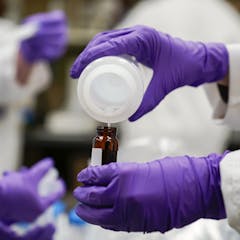
Articles on Environmental health
Displaying 1 - 20 of 153 articles

Durability and the risk of chemicals being released when pipes heat up are just 2 concerns about plastic pipes.

Hajj has grappled with public health and safety risks such as crowd crushes and infectious diseases in the past. It’s now facing an emerging risk: climate extremes.

Nanoplastics are the smallest microplastics, far narrower than a human hair. Very little is known about their composition, structure or how they break down in the environment.

Nobody wants to see an accident involving flammable, corrosive or radioactive material. But understanding the rules put in place to prevent these accidents isn’t easy.

From synthetic fabrics to car exhaust to wildfires, exposure to environmental pollutants push the skin microbiome to adapt in ways that reduce its ability to protect the skin.

Filtering out PFAS is only the first step. These ‘forever chemicals’ still have to be destroyed, and there are many questions about how to do that safely.

These chemicals are now found on almost every part of the planet, including in the bodies of a large percentage of the American public. An environmental health scientist explains the risks.

Microplastics are created when everyday products – including clothes, food and beverage packaging, home furnishings, plastic bags, toys and toiletries – degrade.

Exposure to asbestos can cause the same cancer in dogs as it does in humans. Recent cases of asbestos-contaminated mulch highlight the need to better protect our pets.

The most important factor for disease risk is exposure – you actually have to inhale asbestos fibres to be at risk of disease. But asbestos needs to be treated with caution.

New research provides evidence for the first time that the primary chemical in Roundup is reaching people in nearby homes, and it isn’t just from the food they eat.

This summer is expected to be dry and hot. Here’s what that means for the risk of mosquito-borne diseases.

Scientists found PFAS hot spots in Miami’s Biscayne Bay where the chemicals are entering coastal waters and reaching the ocean. Water samples point to some specific sources.

As Australia heads into summer with an El Niño, it’s important understand and prepare for the health risks associated with extreme weather.

For students to learn in a safe, healthy environment, school administrators must deal with a myriad of potential environmental contaminants, from allergens to cockroaches.

New restrictions on PFAS and other potentially hazardous chemicals in Australia present an opportunity for industry to develop alternatives for new, safe and clean products.

Depleted uranium munitions are bad news for enemy tanks, but are not nuclear weapons, and studies have shown that they pose low risks of radiation or chemical exposure.

Millions of people worldwide are exposed via soil and water to arsenic, whether naturally occurring or related to pollution. Chronic exposure is linked to the formation of cancer stem cells.

The drinking water systems serving over 70 million people may not meet newly proposed water quality standards. It could cost hundreds of billions of dollars to fix that.

The Biden administration is finalizing the first federal limits on two compounds, PFOA and PFOS, in drinking water. These so-called ‘forever chemicals’ have been linked to numerous health effects.
